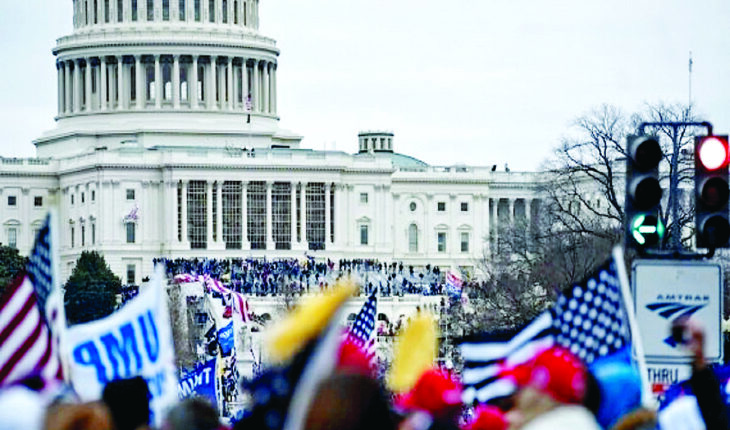Rakesh Sood says Trump is out but Trumpism will be a tougher challenge to deal with,The oldest democracy has been subjected to its most severe stress test; it came to the brink, stared at the abyss and just managed to clear it. The U.S. may have survived the test but considerable damage has been done. Defining pictures of 20,000 National Guard troops deployed in and around the capital, and of an outgoing President who has been impeached a second time in his term, a week before he relinquishes office, have hurt the country’s self-image as also its global standing. It is a grim reminder that democracy, however deeply rooted, can’t be taken for granted and needs constant nurturing and protection to prevent its descent into populism and mobocracy.
The stress test began two months earlier when incumbent President Donald Trump refused to accept the election outcome, alleging that his victory had been stolen through fraudulent means. The 2020 election was the most polarising one the U.S. has seen and what happened on January 6 was its reflection. The certification of the results by Congress will get Trump out of the White House but Trumpism will be a tougher challenge to deal with. In an election that saw the highest turnout (nearly 67%) since 1900, if Joe Biden won over 81 million votes, Trump managed an impressive tally of 74 million. The county-wise election map of the U.S. reveals that Biden won in 509 counties that account for over 70% of the GDP, while Trump won in 2,547 counties that provide the rest.
Even though media channels including Fox News had called the results by November 5, Trump refused to make the traditional concession speech, insisting that the election had been rigged. Legal challenges were mounted by his supporters in many States. By end-November, the recounts had been completed and legal challenges disposed of. The election result remained unchanged. Attorney General William Barr, a Trump supporter, announced on December 1 that the Justice Department had not uncovered any significant fraud that could have affected the election result. On December 14, the Electoral College met in each of the State capitals to formalise Biden’s victory by casting 306 votes for Biden/Kamala Harris versus 232 for Trump/Mike Pence.
The results were conveyed to Congress for certification, but Trump had still not given up. He continued to urge Vice-President Pence, who was to chair the Congress session on January 6, to use his authority to question the returns submitted from the swing States. Pence demurred, pointing out that he had no “unilateral authority” to overturn the electoral votes submitted.
Trump had been urging his supporters to protest in Washington, D.C. against the certification, sending out tweets, “Big protest in D.C. on January 6th. Be there, will be wild!” On that day, he sent them to Capitol, urging, “If you don’t fight like hell, you’re not going to have a country anymore”. Hours later, the mob had stormed the Capitol, disrupting the proceedings. The dedicated Capitol police force proved inadequate and the National Guard was called in. Five people died. After a day that will be remembered as one of the darkest days in U.S. history, Congress certified Biden’s victory clearing the way for him to be sworn in as the 46th U.S. President on January 20.
Yet, the shock at the events and Trump’s role in inciting his supporters led to growing demands for him to step down. Pence was reluctant to invoke the 25th Amendment (it was designed to deal with a president suffering incapacitation) leading to the House passing an impeachment motion on January 13. The charges framed included “threatening the integrity of the democratic system, interfering with peaceful transition of power and imperilling a coequal branch of government”. While many Republicans held Trump responsible, they were reluctant to impeach him. Only 10 of them supported the motion that was carried by 232 votes against 197.
The fate of the impeachment motion is uncertain in the Senate. Senate Republican leader Mitch McConnell, though privately supportive of impeachment, has not indicated how he would vote. Given the requirement of a two-thirds majority for conviction and the Senate at 50-50, it is difficult to gauge if 17 Republican Senators will break ranks with Trump. In 2019, Trump was impeached by the House over his dealings with Ukraine but cleared by the Senate. For the Democrats, the impeachment is as much about Trump as it is about indicting Trumpism. For the Republican Party, however, it is a polarising moment. The question its leaders need to introspect is why they allowed Trump to take over the GOP. A recent poll suggests that 64% of Republican voters remain convinced that the election was stolen. The GOP’s challenge is how to reject Trumpism while retaining the Trump supporters.
The US is not the first democratic society to face this threat. Even as Biden tackles the challenges of COVID-19 and economic recovery, his real challenge will be rebuilding the traditions of democratic discourse aimed at enlarging the centrist consensus. With Harris casting the tie-breaker in the Senate, Democrats control Congress though taking recourse to this thin majority will only exacerbate divisions and mutual recriminations. That is the legacy of Trumpism that must be undone if U.S. democracy has to successfully graduate from its stress test.Rakesh Sood is a former diplomat and currently Distinguished Fellow at the Observer Research Foundation. Views expressed are his own.
The stress test began two months earlier when incumbent President Donald Trump refused to accept the election outcome, alleging that his victory had been stolen through fraudulent means. The 2020 election was the most polarising one the U.S. has seen and what happened on January 6 was its reflection. The certification of the results by Congress will get Trump out of the White House but Trumpism will be a tougher challenge to deal with. In an election that saw the highest turnout (nearly 67%) since 1900, if Joe Biden won over 81 million votes, Trump managed an impressive tally of 74 million. The county-wise election map of the U.S. reveals that Biden won in 509 counties that account for over 70% of the GDP, while Trump won in 2,547 counties that provide the rest.
Even though media channels including Fox News had called the results by November 5, Trump refused to make the traditional concession speech, insisting that the election had been rigged. Legal challenges were mounted by his supporters in many States. By end-November, the recounts had been completed and legal challenges disposed of. The election result remained unchanged. Attorney General William Barr, a Trump supporter, announced on December 1 that the Justice Department had not uncovered any significant fraud that could have affected the election result. On December 14, the Electoral College met in each of the State capitals to formalise Biden’s victory by casting 306 votes for Biden/Kamala Harris versus 232 for Trump/Mike Pence.
The results were conveyed to Congress for certification, but Trump had still not given up. He continued to urge Vice-President Pence, who was to chair the Congress session on January 6, to use his authority to question the returns submitted from the swing States. Pence demurred, pointing out that he had no “unilateral authority” to overturn the electoral votes submitted.
Trump had been urging his supporters to protest in Washington, D.C. against the certification, sending out tweets, “Big protest in D.C. on January 6th. Be there, will be wild!” On that day, he sent them to Capitol, urging, “If you don’t fight like hell, you’re not going to have a country anymore”. Hours later, the mob had stormed the Capitol, disrupting the proceedings. The dedicated Capitol police force proved inadequate and the National Guard was called in. Five people died. After a day that will be remembered as one of the darkest days in U.S. history, Congress certified Biden’s victory clearing the way for him to be sworn in as the 46th U.S. President on January 20.
Yet, the shock at the events and Trump’s role in inciting his supporters led to growing demands for him to step down. Pence was reluctant to invoke the 25th Amendment (it was designed to deal with a president suffering incapacitation) leading to the House passing an impeachment motion on January 13. The charges framed included “threatening the integrity of the democratic system, interfering with peaceful transition of power and imperilling a coequal branch of government”. While many Republicans held Trump responsible, they were reluctant to impeach him. Only 10 of them supported the motion that was carried by 232 votes against 197.
The fate of the impeachment motion is uncertain in the Senate. Senate Republican leader Mitch McConnell, though privately supportive of impeachment, has not indicated how he would vote. Given the requirement of a two-thirds majority for conviction and the Senate at 50-50, it is difficult to gauge if 17 Republican Senators will break ranks with Trump. In 2019, Trump was impeached by the House over his dealings with Ukraine but cleared by the Senate. For the Democrats, the impeachment is as much about Trump as it is about indicting Trumpism. For the Republican Party, however, it is a polarising moment. The question its leaders need to introspect is why they allowed Trump to take over the GOP. A recent poll suggests that 64% of Republican voters remain convinced that the election was stolen. The GOP’s challenge is how to reject Trumpism while retaining the Trump supporters.
The US is not the first democratic society to face this threat. Even as Biden tackles the challenges of COVID-19 and economic recovery, his real challenge will be rebuilding the traditions of democratic discourse aimed at enlarging the centrist consensus. With Harris casting the tie-breaker in the Senate, Democrats control Congress though taking recourse to this thin majority will only exacerbate divisions and mutual recriminations. That is the legacy of Trumpism that must be undone if U.S. democracy has to successfully graduate from its stress test.Rakesh Sood is a former diplomat and currently Distinguished Fellow at the Observer Research Foundation. Views expressed are his own.




